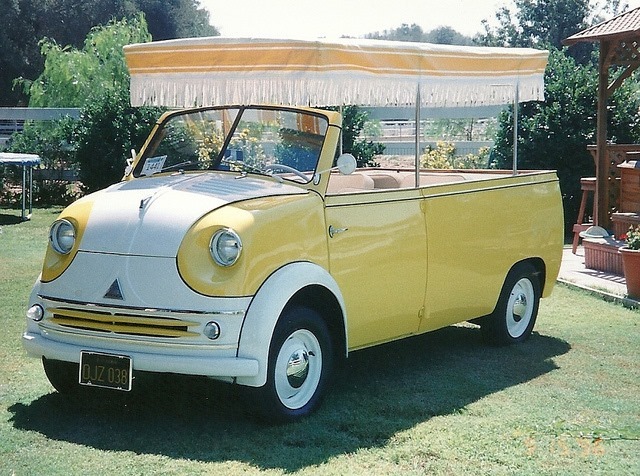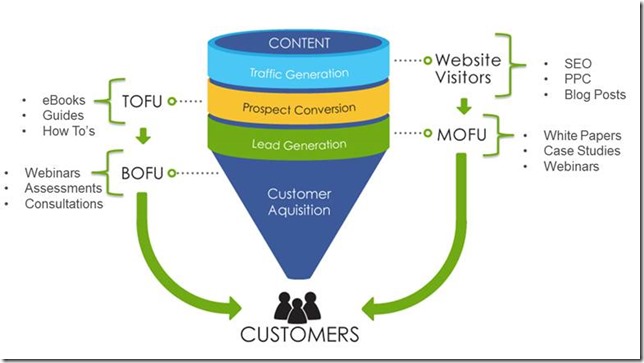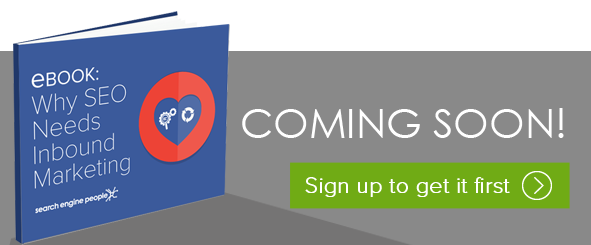Purchase Funnel, Sales Funnel, Marketing Funnel, Customer Funnel and now in the new world of online marketing, we've got the Inbound Marketing Funnel.
Well, what are these and what do they do?
No matter what you call them, they all have the same purpose -- to define and illustrate a customer's journey to a purchase decision.
AIDA Funnel
The original theoretical Funnel was first introduced by Elias St. Elmo Lewis, advertising pioneer and industry proponent, based on his AIDA model. AIDA acronym is comprised of the four most common stages a customer goes through when making a purchase decision - Awareness, Interest, Desire and Action.
Like a real physical Funnel, AIDA model takes on the same shape. It is wider at the top where marketing creates as much awareness for the product or the service as possible through various advertising and marketing activities. The Funnel contracts as the interest winds down, as some of the audience originally reached may no longer be interested. As those still interested in your product move through the Funnel, they may also realize that they don't actually desire it, and will self-disqualify. But there will be a portion of your target audience that will move all the way through the AIDA Funnel by making a purchase decision.
As a marketer working with an AIDA model, your goal is to create as much awareness as possible among your target audience, generate enough interest to move them through a desire stage and finally convert your leads into customers.
AIDA Example

Open top Lloyd Van by Hugo90
To illustrate this concept with a real world example, think of the process of buying a car:
Awareness - during this stage, car manufacturers will compete for potential buyers attention and try to create widespread awareness for their hot new car model. They will run targeted TV ads, radio spots, product placements, newspapers ads and online campaigns.
Interest - now that potential car buyers are aware of new car models on the market, they will actively express interest by paying attention to ads or will visit the manufacturers websites for more information. The automakers will create marketing campaigns and content to gain more interest by showcasing their new models features through a mix of marketing channels including TV ads, online media and even newsprint. They will also highlight consumer reviews and industry testing specs to further cement car buyers interests.
Desire - during this stage, the consumer has an idea what new car shed like to get, but is not yet 100% sure. The manufacturers will run marketing programs targeting consumers in this stage to reassure them of their aspirations to own their new car model by highlighting their cars benefits, use buyer personas that car buyer can easily identify with or even enlist celebrities for endorsements. In the Desire stage, the consumer is also actively engaged by looking for the new cars on the road to see who else is driving them.
Action - in the last stage the consumer will take the necessary steps to get closer to the purchase decision. The car buyer will go out and visit dealerships and test drive new models. Her journey down the marketing Funnel will complete when she makes a purchase. Marketing is still important at this stage. Everything that the car buyer has been experiencing during her purchase decision process must also continue all the way through and live up to her expectations. Failing to do so will prompt her to test drive a competitors vehicle, restart or completely abandon her search.
The stages in AIDA are not all cut and dry, nor does a consumer live in a single stage of the Funnel exclusively at any given moment. there's a great deal of overlap in terms of marketing activities and consumers jump back and forth or even skip stages. that's why you'll often encounter different campaigns for the same product within the same timeframe.
There are also many derivatives of this model. Some stages have different names, some Funnels are longer, others are shorter, but the process is the same across the board, including with Inbound Marketing. Lets take a look how this AIDA model translates into an Inbound Marketing Funnel.
The Inbound Marketing Funnel

The Inbound Funnel is divided into three stages:
TOFu - Top of the Funnel - As with the AIDA model, during this initial stage, the inbound marketers goal is to create awareness by developing content with mass appeal to a specific audience and even related segments. The typical type of content you'd see at the top of the Funnel are things like blog posts, infographics and videos. The subject matter of the content is general interest, educational and informative. The goal is not only to attract traffic, but also to showcase your expertise and build trust to move your visitors to the next stage of the Funnel.
MOFu - Middle of the Funnel - Interest and Desire are grouped together in the Inbound Marketing Funnel as there are a lot of overlapping marketing activities and content happening here. If you were successful in achieving your TOFu goals, some of your visitors will end up Here's and engage with more in-depth content such as case studies, white papers, webinars, and free ebooks. They will even review your testimonials, download product sheets or check out online reviews. Because of their growing interest in your expertise, products or services, more users are willing to share their contact info and opt-in for further communication when downloading your content. During this stage, the content is more targeted towards attracting your ideal customers with a goal of learning as much as possible about them; and qualifying them as leads by moving them through a lead nurturing process and onto the next stage of the Funnel.
BOFu - Bottom of the Funnel - is the end of the visitor to lead to customer journey. Like in the AIDA model, your customer is ready to take some kind of action that will bring them that much closer to the purchase decision. Content and Inbound Marketing activities become a lot more sales focused with offers such as Complimentary Consultations, Free Trials and Demos. Just because your lead is at the end of the funnel and signed up for your trial doesn't mean you've got a customer. Chances are, they've also signed up for your competitors trials. Marketers must still continue their efforts and deliver a great experience to increase the likelihood of your trial user becoming a customer.
- Read also about Lead Nurturing Workflows
Conclusion
Marketing Funnels exist in all shapes and sizes, and they vary from industry to industry. But at their core they all illustrate a common journey of how a customer moves towards a purchase decision. And when your customer reaches the end of the Funnel, it doesn't mean its the final stop. Good Inbound Marketing goes beyond the Funnel by delivering on your promise and delighting your customers.


